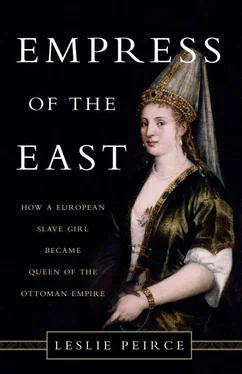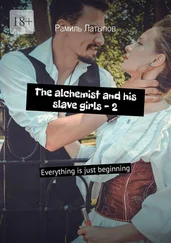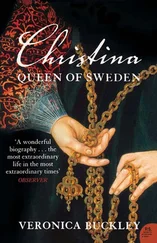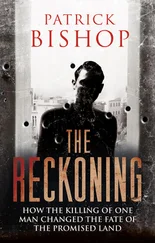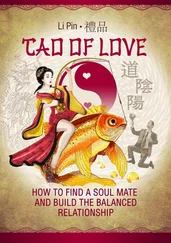Life in the Old Palace was not all parties and policy, however. Instruction took up much of the daily routine, especially for new personnel. The teaching was supervised by the Lady Steward. This powerful majordomo and her staff organized training protocols that sorted out new recruits: promising girls with the talent to join the suites of high-ranking women, others who showed a flair for administration, and the rest, whose lesser aptitude or beauty suggested lesser modes of service.
No one was exempt from instruction, however. Giovanni Maria Angiolello, a Venetian captive who served in the household of a son of Mehmed II, described the training regime to which all were subject but at which only some excelled: “The most senior [women], who are accomplished, teach the new and unrefined to speak and read, and instruct them in the Muhammadan law, and also teach them to sew and embroider, and to play the harp and to sing. They instruct them in all their ceremonies and customs, to the degree that [these girls] have the inclination to learn.” [16] Angiolello, Historia , 128.
The arts of the needle were a universal talent of women in the sixteenth century. [17] Ko, Every Step , 85–88.
For the women of the Old Palace, needlework was, if nothing else, a means of survival. Should they fall on hard times—having been expelled from the royal home for misconduct, say, or retired when the reign of the sultan they served ended—they had a marketable skill to fall back on. Ottaviano Bon, Venetian ambassador in the early seventeenth century, noted that retired palace women could generate income by selling their handiwork to Jewish tradeswomen. [18] Withers, Serraglio , 300.
These female entrepreneurs were valuable intermediaries between the outside world and palace women. The well connected among them could even act as political liaisons for high-ranking women—for example, the woman Strongila, who served Hafsa in this capacity and whose services Roxelana inherited following Hafsa’s death.
Needlework instruction was taken with utmost seriousness. According to Giovanni Antonio Menavino, a Genoese who served Suleyman’s father and grandfather, ten teachers of embroidery came every morning to the Old Palace. Writing in the mid-sixteenth century, Guillaume Postel, French diplomat and scholar of languages, claimed that instruction was restricted to the bulk of recruits who, for “lack of beauty and grace,” would not rise to higher status. These women were nevertheless trained with such care, he observed, that one would think they were the sultan’s own daughters. [19] Postel, République , 33.
Postel was not entirely correct in presuming that only the less talented received instruction. Roxelana herself would acquire sufficient expertise with a needle to send richly embroidered gifts to the king of Poland.
WHY WERE ITALIAN and French audiences hearing about palace women’s devotion to needlework? Was the emphasis on industriousness and sobriety in these European writings an effort to counteract popular European stereotypes of harem wantonness? The question is significant since it was European observers and writers, not the Ottomans themselves, who helped to shape their contemporaries’ ideas of Roxelana by reporting openly about life behind palace walls. Always an object of great curiosity, the sultan’s “seraglio” and its women sold books and generated translations of best sellers from one language to another. Later, in the seventeenth century, when Ottoman armies had proved stoppable and Europeans could feel superior, the theme of the sultan’s lasciviousness and the decadence of empire grew popular.
When Angiolello, Menavino, and Postel were writing, however, the fascination with the Ottomans was more innocent and more comprehensive. The panoptic title of Menavino’s publication Five Books on the Laws, Religion, and Way of Life of the Turks, on the Court, and on Some Wars of the Grand Turk reflected the thirst for knowledge of all things Ottoman. It was a time of both curiosity about and dread of the Ottoman military machine. The conquest of Constantinople in 1453 was not that far in the past; nor was the Ottoman threat that far away. In 1480, Mehmed the Conqueror’s forces had briefly occupied Otranto, on the heel of Italy’s boot, a short sail from Ottoman-controlled territory on the Adriatic. Only his death nine months later muted fears that the empire was bent on a quest for Rome, the “golden apple” of Ottoman legend.
At least in Roxelana’s time, European fascination with the court of the “Grand Turk” and the lives of its females probably owed less to a lurid interest in the sultan’s sex life and more to a shared appreciation that palaces and the monarchs who lived in them were the heart of the matter of sovereignty. Suleyman’s contemporary Francis I replaced the crumbling structures within the medieval fortress of the Louvre with a splendid Renaissance palace, installing there the foundations of what would become the French monarchy’s great art collection. The founder of England’s celebrated Tudor dynasty, Henry VII, spent lavishly on his new Richmond Palace, its finishing touches applied just in time for display at the event that crowned his foreign policy—the marriage of his oldest son Arthur to the Spanish princess Catherine of Aragon. Europeans also took for granted the elaborate separate quarters in which royal women presided over their own courts. In this light, their scrutiny of the domestic education of Old Palace women was not so remarkable. And until Roxelana’s rise to power and notoriety, news of the mundane was probably the best harem news that observers could muster.
For its time, the Old Palace was a veritable institution of higher learning for women. It was the one place in the empire that offered a systematic education for large numbers of females. And it was international in its makeup, commingling individuals from Asia, Europe, and Africa. A new resident need not search far in this Tower of Babel to find another who could speak or at least understand her language. Everyone, of course, had to acquire fluency in Turkish, but other tongues were doubtless spoken in private. Friendships and alliances could be struck through shared vernaculars. Mothers, governesses, and wet nurses, especially young ones with imperfect Turkish, perhaps soothed royal infants with their own childhood lullabies. With a mother and a grandmother whose native tongue was not Turkish, a royal child might acquire a smattering of another language or two.
The Old Palace was, in today’s terminology, a multiethnic and multilingual institution where all were dedicated to mastering a new, shared culture of refinement. It was not wholly unlike European courts that attracted the daughters of ambitious noble families or even royalty. Such was the court of the Archduchess Margaret of Austria, where Roxelana’s contemporary Anne Boleyn began to acquire her sophistication, or the French court, where Anne continued as lady-in-waiting in the queen’s household and Mary Stuart, widow to a French king and queen of Scotland, received a Renaissance education. The difference was that the Old Palace did not provide an education for women of notable Ottoman families. Rather, it created an educated female elite from a population of slaves, albeit a highly select one.
While the Old Palace regime provided its female pupils with the training as well as the opportunity to advance in royal service, its goal was equally to inculcate total allegiance to the empire that had torn them from their homes. Was this careful attention to nurture aimed at uprooting their native cultures as well? Certainly it was imperative to steep recruits, male and female alike, in the religion, etiquette, and political ideology they would now represent. But though it may seem counterintuitive, it was by deliberate design that it was the youth of Christian towns and villages who were drafted into high Ottoman service rather than the seemingly more culturally compatible children of Muslims.
Читать дальше
